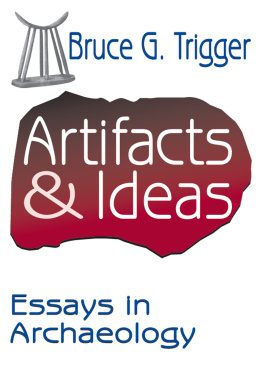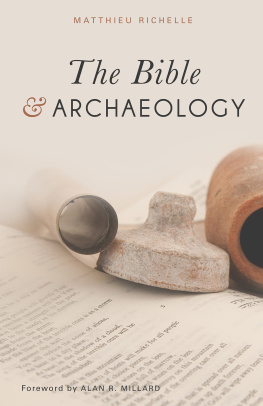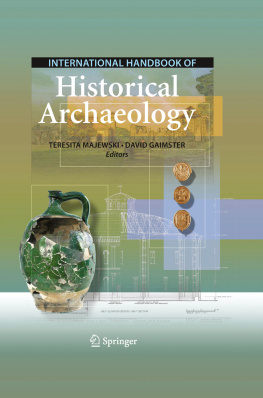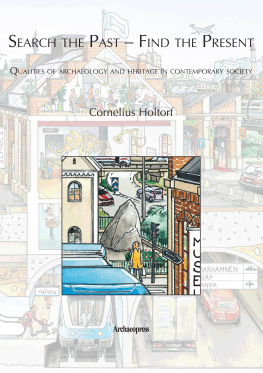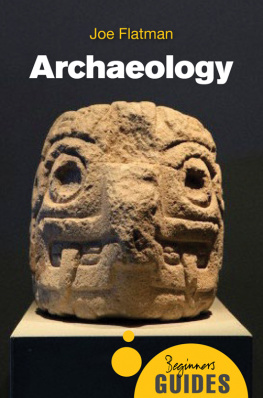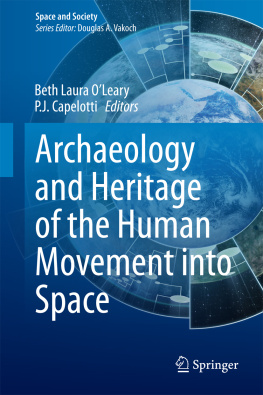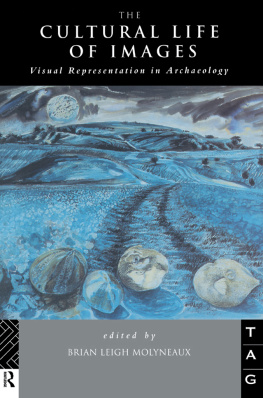Contents

Artifacts & Ideas
Bruce G. Trigger
Artifacts & Ideas
Essays in Archaeology

First published 2003 by Transaction Publishers
Published 2017 by Routledge
2 Park Square, Milton Park, Abingdon, Oxon OX14 4RN
711 Third Avenue, New York, NY 10017, USA
Routledge is an imprint of the Taylor & Francis Group, an informa business
Copyright 2003 by Taylor & Francis.
All rights reserved. No part of this book may be reprinted or reproduced or utilised in any form or by any electronic, mechanical, or other means, now known or hereafter invented, including photocopying and recording, or in any information storage or retrieval system, without permission in writing from the publishers.
Notice:
Product or corporate names may be trademarks or registered trademarks, and are used only for identification and explanation without intent to infringe.
Library of Congress Catalog Number: 2002073208
Library of Congress Cataloging-in-Publication Data
Trigger, Bruce G.
Artifacts and ideas : essays in archaeology / Bruce Trigger.
p. cm.
Includes bibliographical references and index.
ISBN 0-7658-0165-5 (alk. paper)
1. ArchaeologyPhilosophy. 2. ArchaeologyMethodology. 3. Social archaeology. I. Title.
CC72.T75 2002
930.101dc21
2002073208
ISBN 13: 978-1-4128-0650-3 (pbk)
Contents
All chapters except the first are revised versions of previous publications. They are included in this volume with the agreement and permission of the original publishers. The papers published here should not be cited as being identical to the original ones. Rights remain with the original publishers.
, Engels on the Part Played by Labor in the Transition from Ape to Man first appeared in the Canadian Review of Sociology and Anthropology, vol. 4, 1967, pp. 165-176. Reprinted with permission of the Canadian Sociology and Anthropology Association.
, Archaeology and the Image of the American Indian first appeared in American Antiquity, vol. 45, 1980, pp. 662-676. With permission of the Society for American Archaeology.
, Alternative Archaeologies: Nationalist, Colonialist, Imperialist first appeared in Man, vol. 19, 1984, pp. 355-370. With permission of the Royal Anthropological Institute and Blackwell Publishers .
, Archaeology at the Crossroads: Whats New? first appeared in the Annual Review of Anthropology, vol. 13, 1984, pp. 275-300. With permission of the Annual Review of Anthropology, vol. 13, 1984; by Annual Reviews www.AnnualReviews.org.
, Hyperrelativism, Responsibility, and the Social Sciences first appeared in the Canadian Review of Sociology and Anthropology, vol. 26, 1989, pp. 776-797. With permission of the Canadian Sociology and Anthropology Association.
, based on three lectures that were delivered as the 1997 Context and Human Society series sponsored by the Department of Archaeology and the Center for Archaeological Studies at Boston University, were originally published as a single paper titled Archaeology and Epistemology: Dialoguing across the Darwinian Chasm in the American Journal of Archaeology, vol. 102, 1998, pp. 1-34. Each lecture is reprinted as a separate chapter. With permission of the Archaeological Institute of America.
, The 1990s: North American Archaeology with a Human Face? was originally published in Antiquity, vol. 64, 1990, pp. 778-787. By permission of Antiquity Publications Ltd.
Several years ago, Mario Bunge, a distinguished colleague in the Foundations and Philosophy of Science Unit at McGill University and the tireless scourge of much nonsense that currently passes for wisdom in the social sciences, suggested that I should publish a collection of my more recent papers dealing with archaeological interpretation, together with an introductory essay that would relate these papers to each other and to changing modes of interpretation in archaeology. More particularly he wanted me to gather in one place my reactions to changing epistemologies that have influenced archaeology in recent decades.
I wanted such a work to consist of material that was not incorporated in any fundamental way into my later publications and that the papers should address a single, coherent theme. Applying these criteria, I eventually selected nine essays that outline my views about epistemological issues. The earliest of these, published in 1967, is crucial for understanding my position, but all the rest date from the 1980s or 1990s. Each essay has been edited to avoid overlap and remove extraneous material; technical terminology and English usage have been updated; arguments that have become unfamiliar are explained orif no longer consequentialdeleted; passages requiring amplification or clarification have been rewritten; and a standard system of references has been supplied. I have, nevertheless, attempted to preserve the original spirit of each paper. Doing this came naturally to me, as the practitioner of a historical discipline who has long specialized in studying that disciplines intellectual history.
Once I had selected these papers, I realized that they had more thematic unity than I had recognized as I wrote them. Although they are concerned with the theories of knowledge that guide, or can mislead, archaeologists, they are deeply rooted in the ontological realities that constrain the practice of archaeology. As an archaeologist, I am primarily interested in philosophy as it serves the needs and goals of my own discipline. Because of this, the outlook of these papers is quite different from those written by philosophers who use archaeology to explore philosophical issues. The introductory essay () attempts to do what Mario Bunge suggested: it relates the following papers to the development of my own thought and to theoretical developments in archaeology as a discipline during the late twentieth century.
I thank Zarin Machanda for the great amount of help she has given me in preparing these papers for publication. Her word-processing skills have greatly accelerated the work and her superb editorial judgment represents an enduring contribution to the volume. Without her assistance, this book might never have been finished. I also thank Professor Irving Louis Horowitz and Mary Curtis for a timely evaluation of the manuscript, Laurence Mintz for his careful editing, and Stephen Chrisomalis for preparing the index and help with correcting proofs. The expenses of producing the manuscript were defrayed by the stipend attached to my James McGill Professorship. I hope that Mario Bunge will be pleased with the result.
Archaeology might have been invented specifically as a case study for the philosophy of science. While some archaeologists narrowly define the ultimate goal of their discipline as being to explain the archaeological record (Clarke 1968; Dunnell 1971; Schiffer 1976), the vast majority regard their discipline as a social science, the goals of which are to trace the evolution of culture, behavior, and human beings themselves, to delineate the history of individual societies prior to written records, and to ascertain how groups of humans lived in prehistoric times. In Europe, archaeologists tend to identify themselves as historians, while in North America, prehistoric archaeology is a branch of anthropology. Studying human behavior and culture is a task common to both archaeologists and anthropologists.
Yet, with respect to the study of behavior and culture, archaeology is a challenged discipline. Unlike all social scientists, except historians, archaeologists are unable to observe human behavior directly and they have no direct access to human thoughts, whether expressed verbally or in writing. Behavior and ideas must be inferred from the material remains of the past and from the impact humans once had on the environment. Many forms of material culture do not survive for archaeologists to study, except in environments marked by extreme cold or aridity, and the artifacts that do survive are often found in contexts of disposal, not where they were used. To infer human behavior or beliefs from such data is a demanding task and an operation that leaves great scope for subjectivity. The paucity of evidential constraint renders archaeology a very revealing example of how data are interpreted by social scientists.

